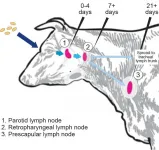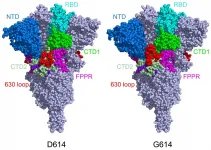(Press-News.org) Many people have never heard of Brucellosis, but farmers and ranchers in the United States forced to cull animals that test positive for the disease and people infected by the animal-transmitted Brucella abortus (B. abortus) pathogen that suffer chronic, Malaria-type symptoms, certainly have.
Brucellosis is an agricultural and human health concern on a global scale. It was introduced over 100 years ago to Bison and elk in Yellowstone National Park by cattle and has been circulating among the wild herds ever since, leading to periodic outbreaks and reinfection. There is no vaccine for humans, and experimental studies of B. abortus in its natural animal hosts are technically difficult, extremely expensive and only a few facilities are capable of conducting these studies.
That did not stop Sean Crosson, MSU Rudolph Hugh Endowed Professor, and colleague Aretha Fiebig, research associate professor in Michigan State University's Department of Microbiology and Molecular Genetics, from bringing sophisticated genomics tools from the lab to the field to gain new insight into how B. abortus infects cattle and help stop the spread of this deadly disease.
The results of their study were published in the Proceedings of the National Academy of Sciences.
"B. abortus primarily infects cattle, causing pregnant cows to abort the fetus, but the infection is typically studied in mouse models, which are not the true host of the bacterium," explained Crosson, who has been studying the bacteria for more than 14 years. "If you want to understand the infection biology underlying bovine disease, then it's helpful to study things in the natural host in a field context."
In the microbiological equivalent to tagging cattle, Crosson and Fiebig harnessed the hopping ability of specialized DNA called transposons to tag individual strains of B. abortus with unique barcodes. This gave them the ability to count how many B. abortus bacteria made it from the cow's eye, a common point of infection in the field, to the lymph nodes.
"As molecular biologists, we can harness hopping DNA by separating away the enzyme that allows it to continue moving," said Fiebig, who specializes in bacterial regulatory mechanisms. "We temporarily gave DNA the ability to hop into the B. abortus genome, but it didn't hop out again."
The scientists mixed millions of E. coli bacteria carrying transposons with millions of B. abortus in a broth containing amino acids and sugars, initiating mass tagging through a process called bacterial conjugation where transposons hop into and unite with the B. abortus genome. When the remaining E. coli cells were washed away, they were left with a vat of individually barcoded B. abortus strains.
"We were able to make a rich pool of about a million different barcoded strains," Fiebig said. "When we infected the cattle, we could track almost every single strain and ask, 'how many strains got lost, what strains had an advantage and was that advantage for a genetic reason or just chance?'"
Millions of bacteria went in, but surprisingly few came out. And while the genetic identity of strains that made it through was random, the number of strains that managed to infect individual lymph nodes was remarkably similar.
"We knew there was some restriction, or infection bottleneck, but we didn't understand the magnitude until this study," said Fiebig.
The unexpected results required nontraditional computational analysis, so Marianne Huebner, director of MSU's Center for Statistical Training and Consulting, provided expert guidance on the use of mathematical models to assess the population structures of the bacteria that survived the bottleneck.
Infecting a large animal host with a federally regulated pathogen also presented significant methodological challenges. The researchers relied on the highly skilled veterinarians and high-tech facilities at the United States Department of Agriculture-Agricultural Research Service's (USDA-ARS) National Animal Disease Center in Ames, Iowa where the cows in the study were housed and treated.
The challenging field study paid off, providing critical insight into just how good the cow's mucosal barrier is at restricting B. abortus during infection.
"In the end, we gained a quantitative understanding of an infection bottleneck via a common route of bovine infection in the field," Crosson said. "This information is useful for scientists studying the epidemiology of Brucellosis in livestock and wildlife and can help us build better transmission models as we work to stop the spread of this disease."
The proof of principle paper also opened new doors to discovering specific B. abortus genes involved in the devastating disease.
"Going forward, we better understand how to use our library of barcoded mutants over longer timepoints in a pregnant host to find B. abortus genes that influence the most severe outcomes in cattle, including abortion," Crosson said. "This is a goal of the USDA-ARS as well, to know what genes in B. abortus are critical to infection in the bovine host."
INFORMATION:
The researchers emphasized that MSU's College of Veterinary Medicine, the College of Natural Science and AgBioResearch in the College of Agriculture and Natural Resources were instrumental in supporting the study.
GRAND RAPIDS, Mich. (March 16, 2021) -- Older age at the time of conception and alcohol consumption during pregnancy have long been known to impact fetal development.
Now, a new report published in Proceedings of the National Academy of Sciences suggests older age and alcohol consumption in the year leading up to conception also may have an impact by epigenetically altering a specific gene during development of human eggs, or oocytes.
Although the study did not determine the ultimate physical effects of this change, it provides important insights into the intricate relationship between environmental exposures, genetic regulation and human development.
"While the outcome of the change isn't clear, our findings give us a valuable look into ...
BOSTON - March 16, 2021 - The fast-spreading UK, South Africa, and Brazil coronavirus variants are raising both concerns and questions about whether COVID-19 vaccines will protect against them. New work led by Bing Chen, PhD, at Boston Children's Hospital analyzed how the structure of the coronavirus spike proteins changes with the D614G mutation -- carried by all three variants -- and showed why these variants are able to spread more quickly. The team reports its findings in Science (March 16, 2020).
Chen's team imaged the spikes with cryo-electron microscopy (cryo-EM), ...
Scientists at the U.S. Department of Energy's Ames Laboratory and their partners from Clemson University have discovered a green, low-energy process to break down polystyrene, a type of plastic that is widely used in foam packaging materials, disposable food containers, cutlery, and many other applications.
Polystyrene is part of a much larger global plastic waste problem. Hundreds of millions metric tons of polymers are produced each year, a large majority of which is discarded after use. Due to the chemical stability and durability of industrial polymers, plastic waste does not easily degrade in landfills and is often burned, which produces carbon dioxide and other hazardous gases. ...
Combining tissue engineering and regenerative medicine, scientists have fabricated a series of heart valve replacements with the ability to incorporate host cells, enabling them to regenerate and grow over time. The valves expanded and maintained their function for a year when implanted into growing lambs, suggesting they could address the dire need for a long-term valve replacement for children with congenital heart disorders. These pediatric patients depend on mechanical or prosthetic heart valves for survival, but current devices often calcify over time and cannot grow alongside the ...
WASHINGTON-- The stormy, centuries-old maelstrom of Jupiter's Great Red Spot was shaken but not destroyed by a series of anticyclones that crashed into it over the past few years.
The smaller storms cause chunks of red clouds to flake off, shrinking the larger storm in the process. But the new study found that these disruptions are "superficial." They are visible to us, but they are only skin deep on the Red Spot, not affecting its full depth.
The new study was published in the Journal of Geophysical Research: Planets, AGU's journal for research on the formation and evolution of the planets, moons and objects of our solar system and beyond.
"The intense vorticity of the [Great Red Spot], together with its larger size and depth compared to the interacting vortices, ...
Toronto, ON -A new study published in the journal Substance Use and Misuse has found that adverse childhood experiences, such as physical and sexual abuse and neglect, predict greater performance-enhancing substance use in young adults.
Analyzing a sample of over 14,000 U.S. young adults from the National Longitudinal Study of Adolescent to Adult Health, researchers found that adverse childhood experiences are strongly associated with both legal (e.g., creatine monohydrate) and illegal (e.g., anabolic-androgenic steroids) performance-enhancing substance use. This relationship was especially strong among individuals who experienced ...
(March 17, 2021) -- Eric Shattuck, assistant professor of research in the UTSA Institute for Health Disparities Research (IHDR) at The University of Texas at San Antonio, is studying the phenomenon of social distancing in response to infectious disease and its effects on pathogen transmission and the health of individuals and communities.
Many animals, including humans, exhibit behavioral changes during the early stages of an infection, including reduced social contacts, called sickness behavior. His findings suggest innate social distancing might help prevent the infection ...
Gun violence in popular prime-time broadcast television dramas has increased steadily over almost two decades, a trend that parallels the rise in U.S. homicide deaths attributable to firearms, according to research by the Annenberg Public Policy Center (APPC) of the University of Pennsylvania.
Overall gun violence on popular prime-time dramas doubled from 2000 through 2018, according to the study, which was published in PLOS ONE. More important, gun violence as a proportion of the violence depicted in the shows rose significantly as well.
"Our research found that gun use substantially increased from 2000 to 2018 on prime-time ...
A study led by researchers at the University of California San Diego Jacobs School of Engineering provides new insights for developing therapies for muscle disease, injury and atrophy. By studying how different pluripotent stem cell lines build muscle, researchers have for the first time discovered how epigenetic mechanisms can be triggered to accelerate muscle cell growth at different stages of stem cell differentiation.
The findings were published Mar. 17 in Science Advances.
"Stem cell-based approaches that have the potential to aid muscle regeneration and growth would improve the quality of life for many people, from children ...
ROCHESTER, Minn. -- Pharmacogenomics is a valuable tool for health care providers to help prescribe the right drug for the right patient to enhance efficacy and avoid side effects.
A new research paper funded in part by the National Heart, Lung and Blood Institute (NHLBI) shows a clear advantage of genetic testing in helping health care providers choose the appropriate anti-platelet drug. Testing helps determine if a patient carries genetic variants in CYP2C19 that cause loss of its function. These variants interfere with the body's ability to metabolize and activate clopidogrel, an anti-platelet medication.
Anti-platelet drugs are given to prevent complications from blood clotting after a procedure to open clogged arteries. These patients can use one of ...


